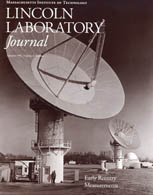Publications
Volume 4, Number 2
 |
|
A Laser-Restructurable Logic Array for Rapid Integrated Circuit Prototyping Laser programming can reduce the time required to customize a logic circuit to minutes without the access and resistance limitations of electrically programmable devices. We have developed a laser-restructurable logic array that can be completely tested before packaging and that can be fabricated with a standard complementary metal-oxide-semiconductor (CMOS) process. Circuits of up to 1200 gate equivalents have been restructured and a base array of 4000 gate equivalents has been fabricated. Future work is aimed at the use of 1-μm design rules to develop arrays that have a complexity of tens of thousands of gates. The Early History of Reentry Physics Research at Lincoln Laboratory During the period from June 1958 through September 1965, Lincoln Laboratory engaged in a reentry measurements program that developed radar and optical instrumentation for observing the phenomena associated with the hypervelocity reentry of payloads into the earth's atmosphere. This article describes both the Lincoln Laboratory effort and the development and launching of reentry test vehicles by NASA. Development of a Mesospheric Sodium Laser Beacon for Atmospheric Adaptive Optics We have developed laser sources of sodium-resonance radiation based on the sum-frequency mixing of Nd:YAG laser radiation. The sources are suitable for generating a fluorescence spot in the earth's mesospheric sodium layer for use in adaptive optics compensation. Taking into account the sodium fluorescence lifetime, Doppler broadening, hyperfine structure, radiative saturation, optical pumping, and radiation pressure, we can optimize the intensity of the fluorescence by using spectral and temporal tailoring of the laser radiation. Airport Surface Traffic Automation Because of a steady increase in air traffic, the Department of Transportation's Federal Aviation Administration (FAA) has instituted a number of programs that are designed to improve safety, reduce delays, and lessen workload intensity for air traffic controllers. The Airport Surface Traffic Automation (ASTA) program, which represents only a small portion of the total FAA effort, uses new technologies and advanced automation techniques to enhance the work of tower controllers, pilots, and vehicle operators. These new techniques are based in part on recent improvements in electronic surveillance, communications, and automation. Surveillance of surface traffic is improved through the use of target data from the new Airport Surface Detection Equipment radar (ASDE-3), or equivalent surface radar, along with the extension of the Mode-S beacon system to the airport surface. Automation processing is improved through new functionality that will be added to the upcoming Tower Control Computer Complex. Finally, tower-to-cockpit communications are augmented by a system of automatically controlled surface lights and a Mode-S two-way digital data link. A Neural Network Architecture for General Image Recognition As part of Lincoln Laboratory's research on neural network technology, a general-purpose machine vision system that can learn to recognize diverse objects has been designed. The system models human vision, primarily with neural networks, and the learning is by example. We tested the system on two disparate classes of objects-military vehicles and human cells-with video images of natural scenes. These objects were chosen because large databases were available and because most researchers judged the two types of objects unrelated. When we trained and tested the system on 40 images of military vehicles, the system was able to recognize the tanks, howitzers, and armored personnel carriers without any errors. Pathologists at Lahey Clinic Medical Center collaborated in the cytology study in which we trained and tested the system on 156 cell images from human cervical Pap smears. The system recognized normal and abnormal (i,e., precancer) cells perfectly. Because of the small number of samples of the military vehicles and Pap-smear cells, these results are preliminary. We should note that the architecture of the system is applicable to many civilian and military tasks. The application depends mainly on training. |
|